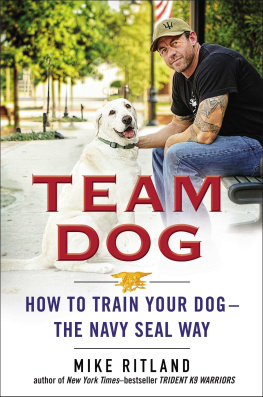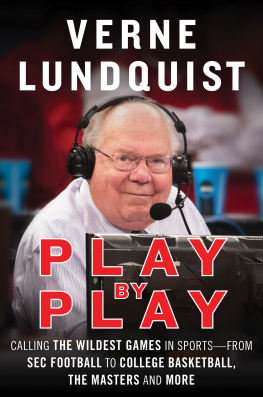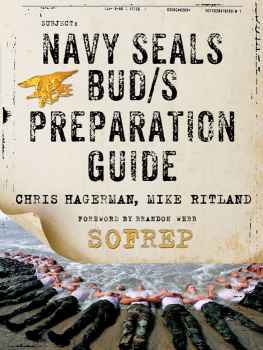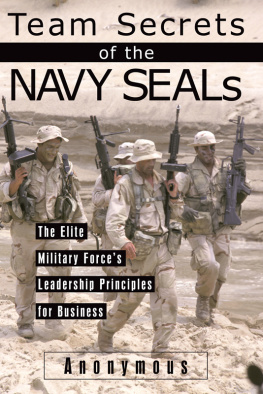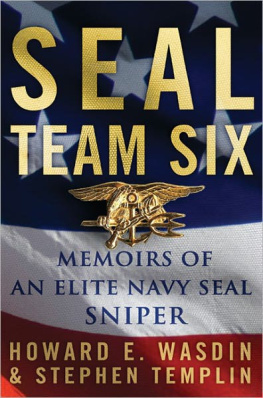
G. P. PUTNAMS SONS
Publishers Since 1838
Published by the Penguin Group
Penguin Group (USA) LLC
375 Hudson Street
New York, New York 10014

USA Canada UK Ireland Australia New Zealand India South Africa China
penguin.com
A Penguin Random House Company
Copyright 2015 by Michael Ritland
All photos 2015 Michael Ritland
Penguin supports copyright. Copyright fuels creativity, encourages diverse voices, promotes free speech, and creates a vibrant culture. Thank you for buying an authorized edition of this book and for complying with copyright laws by not reproducing, scanning, or distributing any part of it in any form without permission. You are supporting writers and allowing Penguin to continue to publish books for every reader.
Library of Congress Cataloging-in-Publication Data
Ritland, Mike.
Team dog : how to train your dogthe Navy SEAL way / Mike Ritland, with Gary Brozek.
p. cm.
ISBN 978-0-698-16064-4
1. DogsTraining. I. Brozek, Gary. II. Title.
SF431.R58 2015 2014028704
636.7'0835dc23
Penguin is committed to publishing works of quality and integrity. In that spirit, we are proud to offer this book to our readers; however, the story, the experiences, and the words are the authors alone.
Version_1
I would like to dedicate this book to my mom, Sandy. She instilled in me the three most important qualities in dog training: patience, consistency, and perseverance. Thank you for being the shining example of what those look like. Love you, Ma.
Contents
Introduction
I t all started with a black Labrador retriever named Bud. I was just a kid when we got him, and the connection between us was instantaneous. I realize now that our initial bond was a bit one-sided. I thought he was the greatest, and he thought, well, I couldnt say for sure what Bud thought. He liked whoever had a leash in hand and was willing to take him on a walk. He liked whoever fed him or offered him popcorn. He was willing to sit, stay, speak, come, and roll over when he knew that popped treat was his reward. He also liked whichever of the upright two-legged creatures fed him, allowed him to empty his bowels and his bladder, tossed him balls, and went with him to explore the outdoors, where his nose was nearly overcome by a series of odors that pleased and sometimes perplexed him.
My dad was usually the one who took Bud on his morning walks. I did the same in the afternoons when I returned from a day at school. Bud wasnt my own dog; he belonged to the family, and each individual member bonded with him to different degrees. It wasnt like I didnt have any human friends, but Bud and I really seemed to like doing a lot of the same thingsbeing outside and exploring the neighborhood, doing anything but sitting around inside. We got along well, and the only real problem we ever had with each other was when my Rollerblade walks with Bud turned into off-pavement excursions, thanks to Buds squirrel and rabbit obsession. I probably ended up looking like a bronco rider with one hand firmly grasping the leash and the other flapping in the breeze above my head.
Bud was an amazing companion, and nothing could beat coming home from a rough day at school and having him greet me with his tail thumping on the floor and him rubbing up against my legs, letting me know how glad he was to see me. That kind of display of affection is most likely the reason why, according to the American Pet Products Association, an estimated 47 percent of households in the United States have a dog. That brings the total number of dogs kept as pets in this country to 83.3 million.
Thats a large number, and I wish I could say that every one of them is a well-adjusted, well-behaved, well-mannered dog. Id also like to say that those dog owners have the best kind of relationship with their dogs. Youve most likely seen some version of what I just described with Bud and me on my Rollerbladesa dog taking an owner for a walk, a hard-charging threat, a jumper, or a food stealer. Those actions dont make them bad dogs, just dogs with bad habits. That doesnt mean that their owners are bad people, just people with bad habits and a poor sense of their own authority.
No one in my family had formal instruction as a dog trainer; we just used the passed-along wisdom of having owned dogs beforethe trial-and-error method combined with a few bits of old wives tales. We were fortunate that Bud was good natured, and that my dad, who did most of Buds early training, applied the same sense of discipline to raising Bud as he did to my two older brothers, my sister, and me. The only difficulties we ever encountered were with lax owners who let a couple of dogs wreak havoc on some of the neighborhood kids and dogs. For a long time, I had a healthy dislike for German shepherds based on my unpleasant interactions with a member of that breed who was the town bully. If you were to ask my dad, hed tell you about an Airedale terrier who ran off his property and jumped Bud. My dad had to intervene, risking serious damage to himself, but he was able to separate the two of them. Bud was on the ropes and my dad saved him.
I share that story because it illustrates a couple of things. First, dogs are animals, and as much as we like to believe that their sweet and gentle nature rules the day, they do have a potential for violent action either when threatened or simply because their genetic makeup drives them to it. Thats true for any breed of dog, though natural faulty wiring is somewhat rare. We never found out what set off that Airedale terrier. His owner was equally mystified. To hear him tell it, the dog had no history of such extreme boundary aggression, but something none of us humans could determine had prompted him to attack on that particular day and in that particular encounter. That said, the dog didnt just suddenly lose his mind, as Ive heard many people say about their dogssomething in the dogs history caused him to respond to my dad and Bud as a perceived threat.
Theres always a reason why dogs react the way they dothe trouble is that we arent always able to discern that cause. This book will help you better read your dog, other dogs, environments, and circumstances to prevent those kinds of unfortunate events from taking place.
The second reason I told that story is because it illustrates the bond between man and dog. Dad was willing to get torn up in order to keep Bud from suffering the same fate.
Its beyond the scope of this book to go into the long history of human/canine relations, but at some point humans and dogs figured out that by working together they would enrich their lives in some way. Id imagine that at some point early humans hunted prehistoric versions of dogs for food. That eventually transitioned into humans recognizing that dogs were also very good hunters and could be used as a tool rather than seen as an adversary. From the dogs perspective, humans had something they wanted, too. They had resources like food and shelter. Most likely that came about as their natural scavenging efforts put them more and more in contact with us. When either we offered them some scrap or they laid claim to what wed left behind, their natural associative way of thinking produced this equation:

